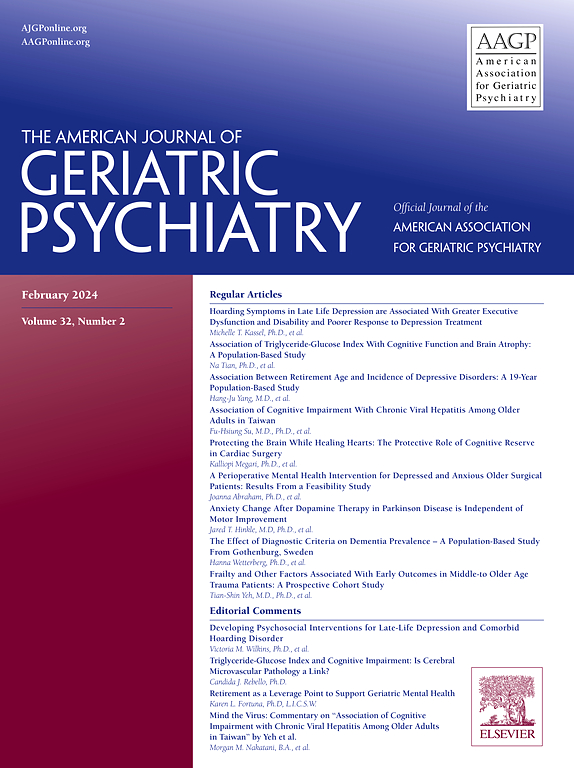39. 冷漠与步态速度在南印度社区居住队列
IF 3.8
2区 医学
Q1 GERIATRICS & GERONTOLOGY
引用次数: 0
摘要
冷漠常见于神经精神疾病,包括帕金森病和阿尔茨海默病,也可能是运动-认知危险综合征(MCR)发展的独立危险因素。关于冷漠的现有文献主要集中在来自高度发达国家的社区居住人群,因此,确定冷漠与运动认知结果之间联系的工作的普遍性尚未得到充分证明。方法从印度喀拉拉邦Kozhikode地区的城市和农村地区招募742名老年人参与这项横断面研究,研究冷漠、MCR、认知障碍和其他人口统计学特征之间的关系。冷漠用冷漠量表评估,抑郁用老年抑郁量表测量。MCR被定义为认知障碍和步态缓慢,步态速度评估为低于年龄和性别调整标准1 SD。采用SPSS软件进行统计分析,包括双变量和回归模型,以评估冷漠、步态速度和MCR之间的关系。结果与最低冷漠分位数的受试者相比,最高冷漠分位数的受试者年龄较大(69.9 vs 67.5岁,p < 0.0001),体力活动较少(每周活动天数为0.9 vs 1.5, p < 0.05),主观一般健康状况较差(p < 0.05),步态较慢(74.9 vs 81.4 cm/s, p < 0.005)。高冷漠受试者也有较低的ACE评分(79.3 vs 84.3, p < 0.0001)和较高的GDS评分(9.6 vs 5.6, p < 0.0001),但没有较高水平的烦躁不安(p=0.1519)。调整前,冷漠与步态速度呈负相关(β = -0.112,p≤0.005),这种关系主要由ACE评分调节。尽管患有MCR的受试者的冷漠水平高于无MCR的受试者(34.6比31.4,p < 0.01),但在logistic回归模型中,MCR的流行与冷漠能力没有显著相关。结论在喀拉拉邦社区居住的老年人中,冷漠与步态速度呈负相关,但与MCR不相关,前者与认知障碍程度的关系被ACE评分所调节。这些发现表明,冷漠可能与步态减慢、MCR和临床显著的痴呆存在连续关系,但未来的纵向研究将需要确定其时间关系。本文章由计算机程序翻译,如有差异,请以英文原文为准。
39. APATHY IS ASSOCIATED WITH GAIT VELOCITY IN A SOUTH INDIAN COMMUNITY DWELLING COHORT
Introduction
Apathy is frequently seen in neuropsychiatric diseases, including Parkinson disease and Alzheimer dementia, and may also be an independent risk factor for the development of motoric-cognitive risk syndrome (MCR). Existing literature on apathy has focused on community-dwelling cohorts from highly developed nations, such that the generalizability of work identifying a link between apathy and motoric-cognitive outcomes has not been fully demonstrated.
Methods
N=742 older adults were recruited from urban and rural areas in Kozhikode district, Kerala, India to participate in this cross-sectional study to examine the relationship between apathy, MCR, cognitive impairment, and other demographic characteristics. Apathy was assessed using the Apathy Evaluation Scale, and depression was measured with the Geriatric Depression Scale. MCR was defined as cognitive complaints and slow gait, with gait speed assessed as 1 SD below age- and sex-adjusted norms. Statistical analyses, including bivariate and regression models, were conducted to evaluate associations between apathy, gait velocity, and MCR using SPSS software.
Results
Compared with subjects in the lowest apathy tertile, those in the highest tertile were older (69.9 vs 67.5 years, p LESS THAN 0.0001), less physically active (0.9 vs 1.5 active days per week, p LESS THAN 0.05), in worse subjective general health (p LESS THAN 0.05) and had slower gait (74.9 vs 81.4 cm/s, p LESS THAN 0.005). High-apathy subjects also had lower ACE scores (79.3 vs 84.3, p LESS THAN 0.0001) and higher GDS scores (9.6 vs 5.6, p LESS THAN 0.0001), but not higher levels of dysphoria (p=0.1519). Before adjustment, apathy was found to negatively correlate with gait velocity (β = -0.112, p≤0.005), and this relationship was principally moderated by ACE score. Although subjects with MCR had higher levels of apathy compared to those without MCR (34.6 vs 31.4, p LESS THAN 0.01), prevalent MCR and apathy tertile were not significantly associated in logistic regression models.
Conclusions
Among community-dwelling older adults in Kerala, apathy is inversely associated with gait velocity but not prevalent MCR, and the former relationship is moderated by degree of cognitive impairment, as determined by ACE score. These findings suggest that apathy may exist on a continuum with gait slowing, MCR, and clinically significant dementia, but future longitudinal studies will be needed to determine a temporal relationship.
求助全文
通过发布文献求助,成功后即可免费获取论文全文。
去求助
来源期刊
CiteScore
13.00
自引率
4.20%
发文量
381
审稿时长
26 days
期刊介绍:
The American Journal of Geriatric Psychiatry is the leading source of information in the rapidly evolving field of geriatric psychiatry. This esteemed journal features peer-reviewed articles covering topics such as the diagnosis and classification of psychiatric disorders in older adults, epidemiological and biological correlates of mental health in the elderly, and psychopharmacology and other somatic treatments. Published twelve times a year, the journal serves as an authoritative resource for professionals in the field.

 求助内容:
求助内容: 应助结果提醒方式:
应助结果提醒方式:


